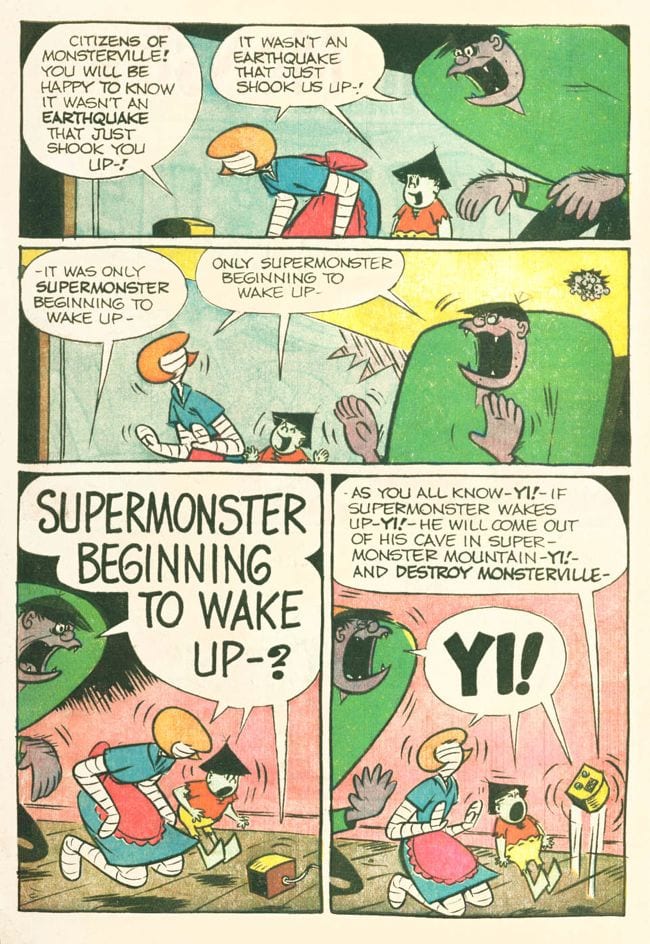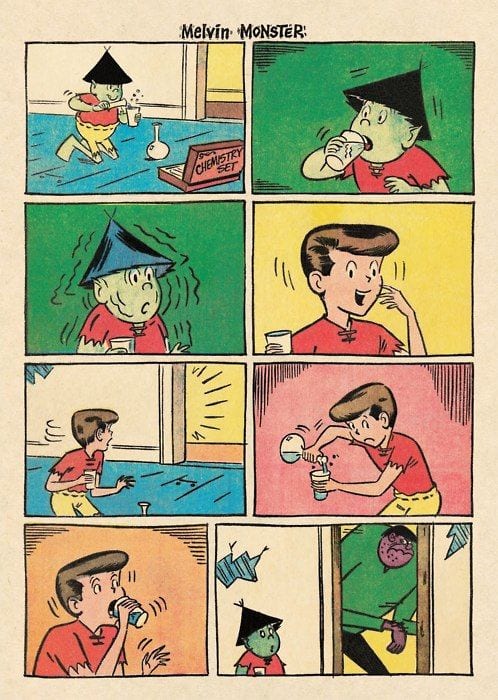The third volume of John Stanley's Melvin Monster is the last, and prints the final issues of the original series. As with all of the volumes in the Seth-designed John Stanley Library, it's aimed primarily at children, and packaged with them in mind. As such, it's designed to flow like a series of stories for anyone to enjoy, rather than acting to preserve a specific set of reprints. That has annoyed a number of collectors, particularly because of the publisher's decision to omit the original covers. Those same collectors will be pleased to know that all of the series' original covers are reprinted in the back of this volume, though eight of the nine covers are reprinted four to a page. While not ideal, Stanley's line is simple enough to convey each cover's gag quite adequately.
The main attraction of this series is Stanley's artwork. The beautiful simplicity of his character design makes each one a walking gag machine. Young Melvin, the kid monster who is a disgrace because he's nice and doesn't get up to mischief like all the other monsters, not only has a pointy head, but that pointy head is integral to any number of jokes. (The best is Melvin shooting himself at an animated totem pole.) A lot of the humor is driven by funny drawings, like a giant monster baby kept in a "crib" that is a cage with a huge padlock on it. When Melvin gets away from him, he's alarmed to discover that the crib has wheels. Another great repeated gag sees his friendly enemy Little Horror turning him into a series of part-boy, part-frog hybrids.
Stanley the writer isn't featured quite as prominently in this volume. Stanley's at his best when he takes a simple premise and is able to craft a complicated plot around it, throwing in gag after gag while escalating the circumstances of the story to hysterical levels before resolving it with a topper gag. Stanley even manages to keep a continued storyline going through a series of shorter stories, each with its own closing gag. You can see this in the fantastic Thirteen (Going On Eighteen), Tubby, and of course his classic Little Lulu comics. Those comics are far less high-concept than the Munsters/Addams Family style of humor found in Melvin Monster, but their stories flow out of the rock-solid characterization developed in each.

In earlier volumes, Stanley tried to develop longer and more complicated storylines surrounding Melvin's status as an outcast in his monster society. His journey to "Human Bean Land" in particular was a highlight, stacking gags as noted earlier. In this installment, Stanley stops attempting this type of story, sticking instead to a stock series of set-ups. Those involve the family's pet crocodile Cleopatra trying to eat Melvin, Melvin trying to enroll in the local school against the wishes of the teacher, and Melvin getting up to shenanigans with Little Horror. Stanley is quite adept at coming up with variations on a gag, but what's disappointing is that he isn't able to evolve the comic's stable of characters nor its stock set-ups over the course of the series. The stories get shorter and the gags get simpler in the last few issues of the original series.
The highlight of the volume is "Supermonster", a story that plays on the weird tension between Melvin and "Baddy," his father. In any other kind of story, the abuse and neglect Baddy heaps on Melvin would cast him as a villain; here, he's mostly just a buffoon doing what everyone else does. That said, Melvin is quite aware that his dad doesn't have his best interests at heart. In this story, Baddy prefers to put his son in harm's way of an all-devouring monster about to wake up from a long sleep rather than confront it himself. Indeed, he hopes to become famous as the father of the little monster who puts Supermonster to sleep! When Melvin enters the monster's cave, Stanley utilizes a series of enormous sound effects to get across the size of the monster and the peril he puts Melvin into. Stanley stacks the action of this strip's gags with a topper gag involving a "stretcher bird's" egg which, after Melvin confuses it for a sleeping pill, winds up attacking Baddy's nose.

The final gag of the series sees Melvin using a chemistry set to turn himself into an ordinary human boy (to his great delight) and then reversing the effect when he hears his father about to walk by. It's a gag that sums up the series. Melvin is a Candide-type innocent, a straight man in a crazy world who desires a normal life but is given nothing but chaos. I think Drawn & Quarterly was wise to market this so directly to children. The figures are simple, direct, and easy to understand. The colors are bright and border on garish (especially the backgrounds, which fill up negative space with non-naturalistic pastels). It features monsters doing silly things and mixes laughter and violence in a way that children always find funny. It's not the sort of series that generates the sort of affection for a character the way Little Lulu does, but it still features a cartoonist in Stanley who understands a trend and how to put his own stamp on it.








